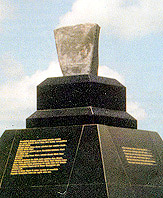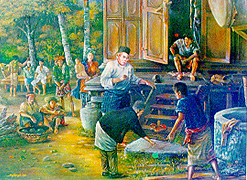Terengganu's Batu Bersurat
- 14th Century Islamic
Inscriptions
on Stone
When Terengganu's famous Inscribed Stone (Batu
Bersurat) was stumbled upon in 1887 at Padang Tara, a village on the
bank of Sungai Tara in Kuala Berang, it was used as a platform for the
washing of feet at the entrance to the Tuk Abdul Rashid mosque. For
fifteen years, the stone functioned as such until a trader named Saiyed
Hussin bin Ghulam Al-Bukhari revealed it to be the important symbol of
Islam that it represents today.
|

|
The Inscribed Stone of Terengganu, besides having
a rich and colourful history, is a profound statement on Terengganu's Islamic
past. The Stone, which dates as far back as the early 14th century (702 Hijrah),
is known to be the earliest piece of inscription in Malay using the Jawi script
which states Islam as the official religion of the state along with an Islamic
law guide pertaining to misdeeds and sanctions.
The Stone, which had broken away at the upper portion, was then placed on a raft
for its journey downstream to Kuala Terengganu. There, it was presented to the
Sultan of Terengganu, Sultan Zainal Abidin III, and subsequently took up an
esteemed place on the famous and panoramic Bukit Puteri.
The Stone, with its wealth of inscriptions on its four faces, has since
journeyed through Malaysia. In 1923, it was loaned to the Raffles Museum of
Singapore before it took up its residence at the National Museum in Kuala Lumpur
when building was completed. On July 6, 1991, the stone was returned to the
Terengganu Government and the state.
 |
It has been speculated from the differing styles of the
inscriptions that more than one engraver was involved. Historians,
however, are still debating on who the engravers were. Whether they were
Arabs, or Malays, or even the Chinese (who were quite renowned for their
chiseling and engraving skills), is still anybody's guess. |
A twelve-tier black and white granite memorial
now stands on the site where the Stone was discovered. The five pillars of Islam
are symbolised by its first five tiers whilst the remaining seven represent the
state's seven regions or districts.
While the original Stone is housed in the majestic Terengganu State Museum, a
replica of the Stone stands atop this majestic memorial. The historical and
religious appeal of the stone has brought in many anthropologists, Islamic
researchers and tourists.

